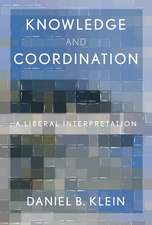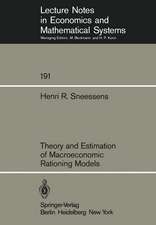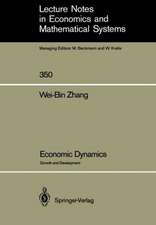Synergetic Economics: Time and Change in Nonlinear Economics: Springer Series in Synergetics, cartea 53
Autor Wei-Bin Zhangen Limba Engleză Paperback – 15 noi 2011
Din seria Springer Series in Synergetics
- 15%
 Preț: 653.14 lei
Preț: 653.14 lei - 17%
 Preț: 430.21 lei
Preț: 430.21 lei - 17%
 Preț: 495.47 lei
Preț: 495.47 lei -
 Preț: 392.37 lei
Preț: 392.37 lei -
 Preț: 396.02 lei
Preț: 396.02 lei -
 Preț: 400.10 lei
Preț: 400.10 lei -
 Preț: 391.02 lei
Preț: 391.02 lei - 15%
 Preț: 641.38 lei
Preț: 641.38 lei - 18%
 Preț: 739.00 lei
Preț: 739.00 lei - 15%
 Preț: 645.60 lei
Preț: 645.60 lei - 15%
 Preț: 637.75 lei
Preț: 637.75 lei - 18%
 Preț: 727.31 lei
Preț: 727.31 lei - 20%
 Preț: 481.77 lei
Preț: 481.77 lei -
 Preț: 398.15 lei
Preț: 398.15 lei - 18%
 Preț: 742.97 lei
Preț: 742.97 lei - 15%
 Preț: 647.40 lei
Preț: 647.40 lei -
 Preț: 416.64 lei
Preț: 416.64 lei -
 Preț: 397.76 lei
Preț: 397.76 lei -
 Preț: 391.99 lei
Preț: 391.99 lei - 15%
 Preț: 644.49 lei
Preț: 644.49 lei -
 Preț: 386.99 lei
Preț: 386.99 lei - 20%
 Preț: 574.08 lei
Preț: 574.08 lei -
 Preț: 387.58 lei
Preț: 387.58 lei - 15%
 Preț: 533.53 lei
Preț: 533.53 lei -
 Preț: 396.02 lei
Preț: 396.02 lei -
 Preț: 390.25 lei
Preț: 390.25 lei -
 Preț: 392.37 lei
Preț: 392.37 lei -
 Preț: 396.40 lei
Preț: 396.40 lei -
 Preț: 408.16 lei
Preț: 408.16 lei - 18%
 Preț: 1116.09 lei
Preț: 1116.09 lei -
 Preț: 397.76 lei
Preț: 397.76 lei - 18%
 Preț: 971.64 lei
Preț: 971.64 lei - 15%
 Preț: 644.30 lei
Preț: 644.30 lei -
 Preț: 386.81 lei
Preț: 386.81 lei -
 Preț: 398.15 lei
Preț: 398.15 lei
Preț: 388.52 lei
Nou
Puncte Express: 583
Preț estimativ în valută:
74.35€ • 79.50$ • 61.99£
74.35€ • 79.50$ • 61.99£
Carte tipărită la comandă
Livrare economică 17 aprilie-01 mai
Preluare comenzi: 021 569.72.76
Specificații
ISBN-13: 9783642759116
ISBN-10: 3642759114
Pagini: 264
Ilustrații: XV, 246 p.
Dimensiuni: 170 x 242 x 14 mm
Greutate: 0.43 kg
Ediția:Softcover reprint of the original 1st ed. 1991
Editura: Springer Berlin, Heidelberg
Colecția Springer
Seria Springer Series in Synergetics
Locul publicării:Berlin, Heidelberg, Germany
ISBN-10: 3642759114
Pagini: 264
Ilustrații: XV, 246 p.
Dimensiuni: 170 x 242 x 14 mm
Greutate: 0.43 kg
Ediția:Softcover reprint of the original 1st ed. 1991
Editura: Springer Berlin, Heidelberg
Colecția Springer
Seria Springer Series in Synergetics
Locul publicării:Berlin, Heidelberg, Germany
Public țintă
ResearchCuprins
1. Introduction.- 2. Time and Change in Economics.- 2.1 Economic Evolution — An Introduction.- 2.2 Equilibrium Theories in Economic Analysis.- 2.3 Dynamic Theories in Economics.- 2.4 Samuelson’s Correspondence Principle and Its Limitations.- 2.5 Instabilities in Economic Analysis.- 3. Mathematical Aspects of Dynamic Systems.- 3.1 Dynamics and Equilibrium.- 3.2 Classifications of Two-Dimensional Differential Equations.- 3.3 The Principle of Linearized Stability.- 3.4 Lyapunov’s Direct Method.- 3.5 Structural Stability.- 3.6 Conservative Systems.- 3.7 Bifurcation Theory.- 3.8 Singularity Theory.- 3.9 Catastrophe Theory.- Appendix: Remarks on Bifurcation Theory.- 4. Multiple Equilibria and Structural Changes in Economic Systems.- 4.1 Catastrophe Theory and Comparative Statics Analysis.- 4.2 Modeling Regional Dynamics.- 4.3 Some Examples of Structural Changes.- 4.4 A Bifurcation Analysis for an Economic Growth Model.- 4.5 Singularity Theory in Economic Analysis.- 4.6 Remarks.- 5. Economic Cycles.- 5.1 Theories of Economic Cycles.- 5.2 Some Mathematical Results Related to Limit Cycles.- 5.3 The Simplified Keynesian Business Cycle Model.- 5.4 Non-equilibrium in a Disequilibrium Model.- 5.5 Monetary Cycles in the Generalized Tobin Model.- 5.6 Oscillations in van der Ploeg’s Hybrid Growth Model.- 5.7 Periodic Optimal Employment Policy.- 5.8 Optimal Economic Growth Associated with Endogenous Fluctuations.- 5.9 Remarks on Possible Further Bifurcations from Limit Cycles.- 5.10 Competitive Business Cycles in an Overlapping Generations Economy — A Discrete Model.- 6. Economic Chaos in Deterministic Systems.- 6.1 Chaos in Deterministic Systems.- 6.2 Economic Chaos in a Discrete System.- 6.3 Aperiodic Optimal Economic Growth.- 6.4 Urban Dynamics — The Lorenz System.- 6.5Chaos in an International Economic Model.- 6.6 Chaos and Economic Forecasting.- 6.7 Remarks.- Appendix: Some Criteria for Distinguishing Different Attractors.- 7. Stochastic Processes and Economic Evolution.- 7.1 Random Processes and Economic Evolution.- 7.2 Stochastic Processes — An Introduction.- 7.3 Birth-Death Processes and the Master Equation.- 7.4 A Non-equilibrium Model of the Schumpeter Clock.- 7.5 Effects of Noise on the Nonlinear Stochastic Systems Close to Critical Points.- 7.6 Effects of Random Environment on a Two-Dimensional Deterministic System Near Critical Points.- 7.7 Conclusions.- 8. Urban Pattern Formation Process — Stability, Structural Changes and Chaos.- 8.1 Continuous Spatial Economics and Description of Urban Pattern Formation.- 8.2 The Implications of Structural Stability in the Two-Dimensional Economy.- 83 Economic Cycles in Puu’s Spatial Multiplier-Accelerator Business Model.- 8.4 Spatial Diffusional Effects as a Stabilizer.- 8.5 Separation and Coexistence of Residents.- 8.6 Long-Term Traveling-Wave Urban Pattern.- 8.7 Instabilities and Urban Pattern Formation.- Appendix: Structural Changes in Two Pattern Formation Models.- 9. The Haken Slaving Principle and Time Scale in Economic Analysis.- 9.1 The Haken Slaving Principle.- 9.2 The Center Manifold Theorem.- 9.3 Singular Perturbations.- 9.4 Fast Variable Versus Slow Variable in Economic Analysis.- 9.5 The Time Scale in Economic Analysis.- 9.6 Another Problem — Understanding a Dynamic Man.- Appendix: The Slaving Principle for Stochastic Differential Equations.- 10. Implications of Synergetic Economics.- 10.1 Synergetic Economics and Its Relations to Synergetics.- 10.2 Relations to Traditional Dynamic Economics.- 10.3 Competitive and Planned Economies and Synergetic Economics.- 10.4Implications for Developed and Developing Economies.- 10.5 Chance and Necessity in Economic Life.- 10.6 Policy Decision in a Chaotic World.- 10.7 Relations Between Microeconomics and Macroeconomics.- 11. Conclusions and Prospects for Further Research.- References.


























